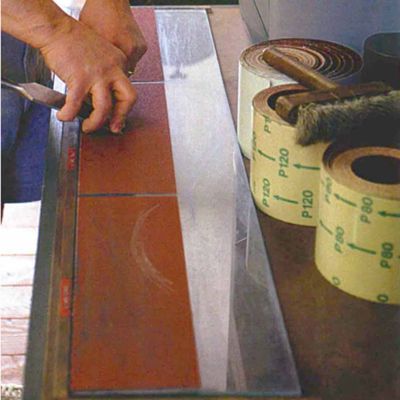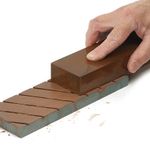
Synopsis: Sharpening techniques that work for one person might not work for another, so Jefferson Kolle trailed three New England woodworkers to get their secrets on honing edges. Drawings and photos show how each expert produces a sharp edge on hand tools. Scott Schmidt prefers Japanese waterstones and shares his four-stroke method and a cinder-block secret. Garrett Hack favors traditional oilstones and kerosene, and he occasionally uses diamond paste to get a keen edge in hard steel. Mike Dunbar’s so-called “scary sharp” method involves plate glass and sandpaper, which is portable and fast. Find out which woodworker’s favorite wins over the author.
Many years ago, as the new, inexperienced guy on the carpentry crew, I was in charge of lugging giant piles of plywood from one side of the job site to the other. “I went to college for this?” I used to ask myself. There was a guy on the crew, Mark Fortenberry, who had the sharpest tools. He made finish work look effortless—smooth, fluid, precise. Every morning he’d pour coffee from his stainless-steel thermos and sharpen the tools he needed for the day. Different colored stones were unwrapped from an oily towel; a little can of three-in-one oil appeared; and Mark would sharpen.
Knowing I would need to acquire tools and skills if I ever wanted to do anything other than get intimate with sheet after sheet of rough plywood, I bought a block plane and a roll of chisels, the same plane and chisels that Mark had. But there was something wrong with my tools—maybe they were defective. The problem was they were dull. “Dull as a hoe,” Mark said.
Eventually I got lots of tools: tools I used everyday, tools I didn’t really need, tools I never used. And I got my grandfather’s two sharpening stones—oily, black things, one with a big chip out of the corner. Often when I tried to sharpen something, I think I made it duller. (What’s duller than a hoe? A hoe handle, maybe.) The whole process mystified me. I decided that electricity would remove the mystery of sharpening, so I bought a powered waterstone made by Makita.
It’s a great tool: The platterlike, 7-in., 1,000-grit stone moves at fewer than 600 rpm, and water drips onto its surface from a plastic reservoir. The tool comes with a honing guide and an attachment for holding planer or jointer blades. It couldn’t be more jerk-proof. Fill the reservoir with water, turn on the tool and hold the blade against the stone. The motor thrums along quietly, reassuringly, telling you that now, finally, you are going to get truly sharp tools. And I did. For the first time since Mark sharpened some of my stuff, my plane irons and chisel blades would shave hair off my forearm.
Eventually I went into business for myself, restoring houses, building an occasional piece of furniture, and the Makita never failed me. I got to the point where I stopped using the honing guide. Instead, I held blades freehand against the turning stone, and after a while I wore a trough in the stone, which made it harder and harder to get a flat edge. If the machine has a fault, it is that it is messy. Water gets flung around, especially when you’re trying to true the back of a blade. Every time I sharpened, my shirt would get soaked right at my belt line, and I would have to mop water off the workbench when I was through.
From Fine Woodworking #140
For the full article, download the PDF below:
Fine Woodworking Recommended Products

Stanley Powerlock 16-ft. tape measure

Norton Water Stones

Veritas Wheel Marking Gauge






















Log in or create an account to post a comment.
Sign up Log in